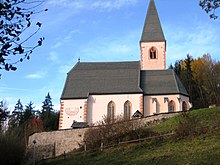Filial church of St. Kosmas
The branch and pilgrimage church of St. Kosmas in the municipality of Mölbling is consecrated to Saints Cosmas and Damian and belongs to the Roman Catholic parish of St. Stefan am Krappfeld .
history
It was first mentioned in a document in 1277. In the second half of the 15th century, the church was converted into a fortified church. In 1456 the church was consecrated by Bishop Johannes Schallermann . In 1479 the Turks are said to have besieged the church in vain. Around 1480, Hungarian troops from King Matthias Corvinus stormed the church. In 1529 it was re-consecrated.
Building description
The church is a uniform, late Gothic building with stone slab roofs. The tower north of the choir has acoustic windows adorned with tracery on the south and east sides and has a pyramid roof. One bell was cast by Rupert Dringer in 1435, and another by Mathias Landmann in 1687. To the east of the tower is a baroque oratory , to the west a sacristy from 1735. The low, slightly recessed choir is supported by delicate, three-tiered buttresses . The nave is widened to the west on both sides around the gallery stairs. Original plasters from the 16th century have been preserved on the south side of the nave. The church has grooved portals on the north and south sides. The north portal is walled up from the inside. Both portals have doors covered with iron plates, each with a triangular shooting hole in the lower part. On the west facade there is a round window at the top and a rectangular window fastened with a double iron grille at the bottom. The crucifix was made around 1800.
In the single-nave, four-bay nave, a ribbed vault rests on recessed pillars with semicircular templates. The two-axis west gallery is arched under a ridge. In the two-bay choir with five- eighth end, a ribbed vault rises above short services supported by figuratively decorated consoles . The keystones in relief show the Lamb of God and the hand of God. A grooved pointed arch portal with a door covered with iron plates leads into the sacristy. Some of the tracery windows have fish bubbles.
Facility
Johann Pacher created the uniform, high-quality furnishings of the church . The center of the high altar from 1754 with its slightly swinging architecture is a enthroned Madonna in a halo, with Saints Cosmas and Damian kneeling in front of it. To the side of it are the statues of the holy deacons Stephen and Laurentius . In the essay, the figure of God the Father is flanked by Saints Barbara and Ursula .
On the left side altar, a pietà is surrounded by angels with instruments of passion . In the barred niche under the altar shrine, the poor souls are depicted in purgatory. The right side altar bears a statue of St. Wolfgang and in the top a statue of St. Catherine in clouds. Saint Wolfgang is surrounded by the figures of a guardian angel , Christ with a cross and the archangel Michael .
The strongly curved pulpit was built around 1750/60 and is attributed to Johann Pacher. It bears the figures of the four evangelists and depicts the Good Shepherd , Moses and the sacrifice of Abraham in the reliefs of the parapet . On the cover are the allegories of the Christian virtues of faith, love and hope, as well as those of transience.
A baroque crucifixion group from the beginning of the 18th century is attached above the retracted triumphal arch . On the north wall of the gallery you can see an enthroned Maria Immaculata from the second half of the 18th century. The twelve apostles are depicted in seven oil paintings on the choir walls. In the nave there are pictures of Francis of Assisi with the baby Jesus, of Mary's lessons and of Joseph with the baby Jesus.
The inlaid prayer stalls come from the middle of the 18th century.
Others
The baroque, former cemetery chapel was adapted into a funeral hall in 1998. To the north of the church is the so-called Peststein.
literature
- Dehio manual. The art monuments of Austria. Carinthia . Anton Schroll, Vienna 2001, ISBN 3-7031-0712-X , p. 752 f.
- Siegfried Hartwagner: Austrian Art Monograph Volume VIII: Carinthia. The St. Veit an der Glan district . Verlag St. Peter, Salzburg 1977, ISBN 3-900173-22-2 , p. 185 ff.
Coordinates: 46 ° 52 ′ 14.5 " N , 14 ° 25 ′ 32.7" E
